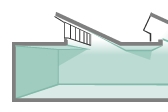
Saw tooth roofs were traditionally an industrial/warehouse type roof. They are now increasingly popular in houses, thanks to the amount of daylight they allow.

What is a sawtooth roof?
The ‘sawtooth’ roof design is most commonly seen on older factory buildings. The profile of these type of buildings is similar in shape to the teeth of a saw – hence the name… It may also resemble a continuous row of skillion roofs.
With a sawtooth roof, the vertical aspects of the roof are fitted with windows or glass panels. The building is generally angled so the glass panels face to the north, which filters the light and avoids direct exposure.
Why install a sawtooth roof?
The sawtooth design was developed to help provide good lighting in interior spaces in the days before electric lighting was commonplace. The design aimed to harness ‘daylighting’ – particular building strategies and techniques which maximise the positive effects (namely light and warmth) which result from allowing sunlight into a building, while reducing problems like glare and overheating.
Once artificial lighting became more widespread, sawtooth roof buildings became less commonplace – or they remained, but had the glass panels replaced with solid materials such as metal.
Renewed interest in energy saving has seen the sawtooth design become more popular in recent years. Innovations such as cool roofs and radiant barriers have been introduced in order to improve the passive cooling features of sawtooth roofed buildings. Without these additional features, buildings which incorporate a sawtooth roof have a tendency to overheat – but a sawtooth roof can offer big advantages in terms of natural light and passive heating and cooling if it’s carefully planned.
What materials are used in a sawtooth roof?
Windows which use low-e glass or window film can help to reduce radiant heat admitted via sawtooth roofs. Well insulated roofs with reflective finishes should also be considered. Sawtooth roofs tend to be made from metal.
|
Advantages
|
Disadvantages
|





